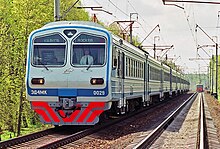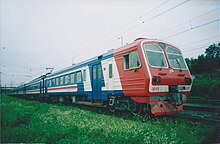ED4 (Electric trainset)
You can help expand this article with text translated from the corresponding article in Russian. (April 2022) Click [show] for important translation instructions.
|
You can help expand this article with text translated from the corresponding article in Ukrainian. (April 2022) Click [show] for important translation instructions. |topic= will aid in categorization.Content in this edit is translated from the existing Ukrainian Wikipedia article at [[:uk:ЕД4]]; see its history for attribution.{{Translated|uk|ЕД4}} to the talk page. |
| ED4 | |
|---|---|
 | |
| Manufacturer | DMZ |
| Replaced | ER2 |
| Constructed | from 1996 |
| Entered service | from 1997 |
| Number built | 475 (as of August 2014) |
| Formation | 4, 6, 7, 8, 9, 10, 11, 12 cars |
| Operators | Russian Railways |
| Depots | 3+ |
| Lines served | 5+ |
| Specifications | |
| Car body construction | steel, aluminium |
| Train length | (4) 88.224 m (289 ft 5+3⁄8 in) (6) 132.336 m (434 ft 2+1⁄8 in) (7) 154.392 m (506 ft 6+3⁄8 in) (8) 176.448 m (578 ft 10+3⁄4 in) (9) 198.504 m (651 ft 3+1⁄8 in) (10) 220.56 m (723 ft 7+1⁄2 in) (11) 242.616 m (795 ft 11+3⁄4 in) (12) 264.672 m (868 ft 4+1⁄8 in) |
| Car length | 22.056 m (72 ft 4+3⁄8 in) |
| Width | 3,522 mm (11 ft 6+5⁄8 in) |
| Height | 4,253 mm (13 ft 11+1⁄2 in) |
| Maximum speed | 130 km/h (81 mph) |
| Acceleration | 0.67 m/s2 (2.2 ft/s2) |
| Deceleration | 0.65 m/s2 (2.1 ft/s2) |
| Electric system(s) | 3 kV DC Catenary |
| Current collector(s) | Pantograph |
| Coupling system | SA3 |
| Track gauge | 1,520 mm (4 ft 11+27⁄32 in) Russian gauge |
ED4 (Electric train Demikhovskiy 4-th modification) are a series of Russian electric trainsets, in production since 1996. The trains are produced by DMZ and currently in service on RZD lines in almost every part of the country and former USSR states.
Production history
[edit]
The ED4 was designed to accommodate Russia's need for a domestically produced electric train-set. Russia's most widely exploited electric trains, the ER1 and ER2 series, were produced by the Rīgas Vagonbūves Rūpnīca (RVR) plant in Latvia before the collapse of the USSR.
Design work began in 1996 on the basis of the earlier ED2 series, which were largely equipped with RVR components. Electronic equipment for the new train was manufactured by The Novocherkassk Electric Locomotive Plant, while the drive-train was built in Novosibirsk. ED4 train-cars are nearly identical to those used by both the ER29, and ED2T trains, differing mainly in having notably wider doors.
After successfully completing testing, the first train entered service at the Mineralnye Vody Depot of the North Caucasus Railway.
Only 5 trains carry the early ED4 identification, as the second variant, ED4M, began exclusive production thereafter. The main difference between the two trains is the equipment and shape of the operator's compartment.[1]
Four of the early ED4 trains are in currently in service on the Moscow Railway, one on the North Caucasian Railway, and one in Belgorod.[2]
Variants and modifications
[edit]ED4M
[edit]
ED4M1
[edit]
ED4MK
[edit]
ED4MKu
[edit]
ED4MKM
[edit]
ED4MKM-AERO
[edit]Mechanically almost identical to the ED4MKM, these trains have an updated interior, modified for the needs of airport commuters. The AERO trains are in service in Moscow and St.Petersburg, serving the Domodedovo, Vnukovo, Sheremtyevo and Pulkovo airports, respectively. The modified door mechanisms of the AERO were used on all later ED4M trains.[3]
ED4E
[edit]
See also
[edit]- The Museum of the Moscow Railway, at Paveletsky Rail Terminal, Moscow
- Rizhsky Rail Terminal, Home of the Moscow Railway Museum
- Varshavsky Rail Terminal, St.Petersburg, Home of the Central Museum of Railway Transport, Russian Federation
- History of rail transport in Russia
References
[edit]- ^ "Information about ED4". Archived from the original on 2 April 2015. Retrieved 25 August 2015.
- ^ Service of ED4 in Russia
- ^ Video
External links
[edit]- ЭД4М на сайте Демиховского машиностроительного завода – Website of the Demikhovo Machine-building plant (Russian)
- История электропоездов серии ЭД4 (Russian)
- Презентация первого частного электропоезда повышенной комфортности ЭД4МКу-0151 (Russian)
- RZD ED4M @ Trainspo
- AEX ED4MKM-Aero @ Trainspo
